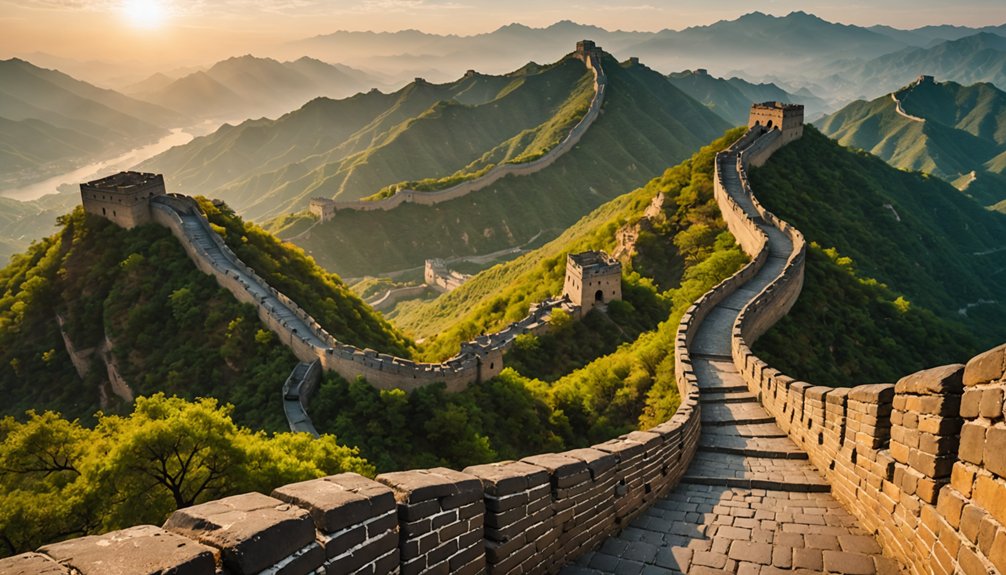Visit China during the shoulder seasons of March-May or September-November to experience ideal temperatures between 10-23°C (50-73°F) and avoid peak tourist crowds. You’ll enjoy 20-30% savings on accommodations and flights while still catching cultural events like the Qingming Festival or Mid-Autumn celebrations. These periods offer the perfect balance of comfortable weather and authentic experiences, with dramatically fewer visitors at major landmarks. Understanding China’s diverse regional patterns will help you plan an even better trip.
Explore East Asia
Find the perfect time to visit these travel hotspots
Key Takeaways
- Spring (March-May) and Autumn (September-November) offer ideal temperatures of 10-23°C with significantly reduced crowds at major attractions.
- Shoulder seasons provide 20-30% savings on accommodations and flights compared to peak summer months.
- Avoid Spring Festival period (Chinese New Year) when 9 billion trips are expected in 2025, causing massive overcrowding.
- October’s National Day Golden Week sees over 300 million domestic travelers, making it one of the busiest periods.
- March and November offer excellent weather conditions without crowds, perfect for visiting popular destinations like the Great Wall.
When Peak Travel Season Hits China
China’s peak travel seasons create massive surges in both domestic and international tourism throughout the year. You’ll need flexible travel plans to navigate these intense periods, particularly during the Spring Festival when a staggering 9 billion trips are expected in 2025, marking a 7% increase from the previous year. The most sought-after Spring Festival destinations include Beijing and Shanghai, leading a list of premier travel hotspots.
The summer vacation months of July and August see a 40% spike in hotel bookings, while October’s National Day Golden Week draws over 300 million domestic travelers. You’ll face significant transportation challenges during these peaks, with railways handling 14,000+ daily trains and airports scheduling 18,500 flights. The May holiday period isn’t much quieter, with flight bookings up 18% year-over-year. Even winter brings its own surge, especially in northern destinations like Harbin, where bookings have jumped 460%. Major attractions implement strict visitor caps, with places like the Forbidden City limiting daily entries to 40,000 people.
Exploring China’s Regional Weather Patterns
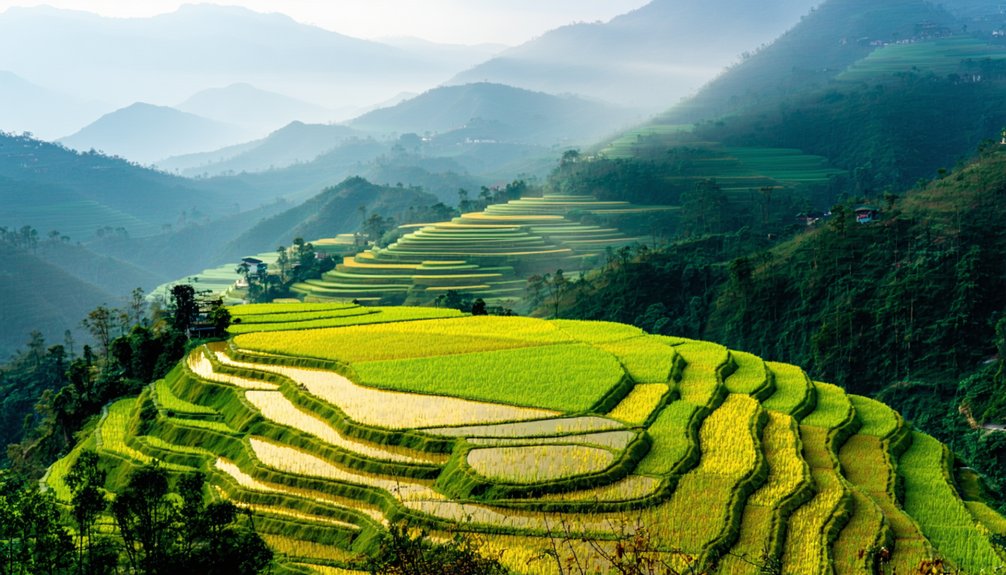
Why does weather vary so dramatically across China? The country’s vast size and diverse landscapes create distinct climate zones, from tropical Hainan to the frigid northeastern regions.
| Region | Key Weather Characteristics |
|---|---|
| North | Continental climate; winters below 0°C, hot summers |
| Southeast Coast | Subtropical; steady 11°C-35°C year-round |
| Northwest | Arid; less than 200mm annual rainfall |
| Tibet Plateau | Alpine; extreme temperature swings |
| Central Plains | Temperate; four distinct seasons |
You’ll encounter dramatic temperature variations as you travel across regions. While Mohe can plunge to -53°C in winter, Xinjiang’s Sanbao Township has recorded a scorching 52.2°C. Precipitation patterns follow a southeast-to-northwest gradient, with annual rainfall ranging from 2,000mm along the coast to less than 20mm in the Turpan Basin. The summer monsoon brings 60-80% of yearly rainfall between June and August, while northern regions experience winter drought with minimal precipitation from December through February. Cities like Shijiazhuang and Xianyang often experience heavy smoggy weather conditions from November to January.
Major Chinese Festivals and Cultural Events

While China’s weather patterns shape when you can visit, the country’s vibrant festivals offer another compelling reason to plan your trip strategically. From the bustling Spring Festival celebrations to the serene Qingming observances, each event provides unique cultural insights.
For alternative festival celebrations away from crowds, consider visiting during Mid-Autumn Festival in October, when you’ll discover hidden cultural gems in local neighborhoods hosting lantern displays and night markets. The Dragon Boat Festival offers exciting races and traditional zongzi tasting in less-visited provinces, while Qingming Festival provides opportunities to explore blooming landscapes and historic sites with fewer tourists. The traditional Tomb Sweeping Day rituals allow visitors to witness Han and minority ethnic groups paying respects to their ancestors.
However, you’ll want to avoid National Day Golden Week unless you’re comfortable with intense crowds and inflated prices. Instead, time your visit around lesser-known regional festivals or plan for shoulder seasons when you can still experience cultural traditions without the overwhelming tourist presence.
Shoulder Season Travel Benefits
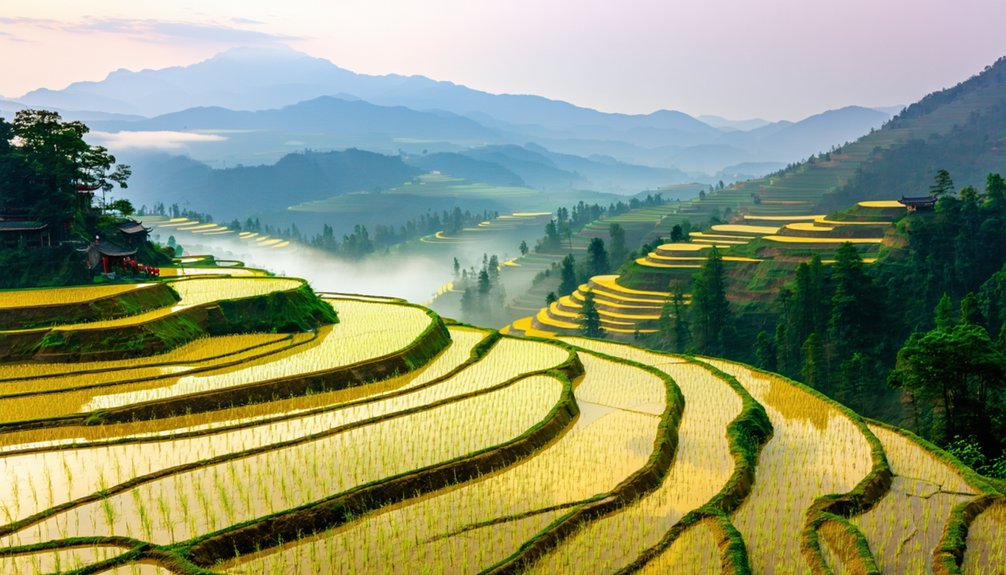
Traveling to China during shoulder seasons (spring and autumn) offers you significant cost savings of 20-30% on flights, accommodations, and attractions while experiencing dramatically reduced crowds at major landmarks. You’ll benefit from ideal weather conditions with temperatures ranging from 10-23°C (50-73°F), clear skies, and lower humidity levels that make outdoor exploration comfortable. These quieter periods still allow you to experience cultural events and festivals while enjoying more authentic interactions with locals at markets and traditional restaurants. Local residents are often less fatigued by tourists during these off-peak times, creating more opportunities for meaningful cultural exchange.
Lower Costs and Crowds
The shoulder seasons in China offer savvy travelers significant advantages in both cost savings and crowd reduction. You’ll find flight prices drop by around 10% compared to peak summer months, with international fares up to $260 cheaper in late October. Hotel rates decrease by approximately 30%, and you’ll encounter 50-70% fewer visitors at major attractions like the Great Wall.
Traveling during March-April or September-November not only saves you money but also enables more authentic cultural interactions as locals experience less tourist fatigue. You’ll benefit from reduced tourist strain on infrastructure while enjoying cultural festivals, markets, and restaurants that cater primarily to residents. For maximum flexibility and savings, consider visiting during March and November, when you’ll find excellent weather conditions without the crowds of peak season. Travelers should especially avoid the Labor Day holiday from May 1-5 when tourist sites become overwhelmingly crowded with domestic travelers.
Pleasant Weather Conditions
You’ll discover ideal weather conditions during China’s shoulder seasons, with spring (March-May) and autumn (September-November) offering comfortable temperatures ranging from 10-27°C across most regions. The reduced pollution levels provide clearer skies for photography and sightseeing, particularly in northern cities like Beijing. During these months, you can enjoy fewer tourist crowds and more authentic experiences at popular attractions.
- Avoid summer monsoons and winter freezes while enjoying comfortable hiking weather on the Great Wall
- Experience perfect conditions for outdoor exploration with moderate UV levels and extended daylight hours
- Witness natural spectacles like spring cherry blossoms or autumn foliage without extreme temperatures
These seasons provide excellent conditions for diverse activities, from Yangtze River cruises to mountain treks in Huangshan. You’ll find clear visibility for landscape photography and pleasant temperatures for exploring ancient sites like the Terracotta Army without weather-related disruptions.
Cultural Events Balance
Shoulder seasons offer a prime opportunity to experience China’s rich cultural festivals without battling peak tourist crowds. You’ll find festival authenticity at its peak during these periods, particularly during celebrations like Qingming in April and the Mid-Autumn Festival in September. You can witness locals engaging in tomb sweeping rituals as families honor their ancestors during the Qingming Festival.
During these quieter months, you’ll enjoy deeper community engagement through local workshops, traditional ceremonies, and family-hosted experiences. You can participate in activities like mooncake-making or watch authentic dragon boat races in Guilin. With accommodation costs up to 30% lower and reduced airfares, you’re free to extend your stay and immerse yourself in multiple festivals. The flexibility of shoulder season travel lets you spontaneously join cultural activities, from calligraphy classes to silk-weaving demonstrations, creating a more genuine connection with Chinese traditions.
Navigating China’s Holiday Crowds
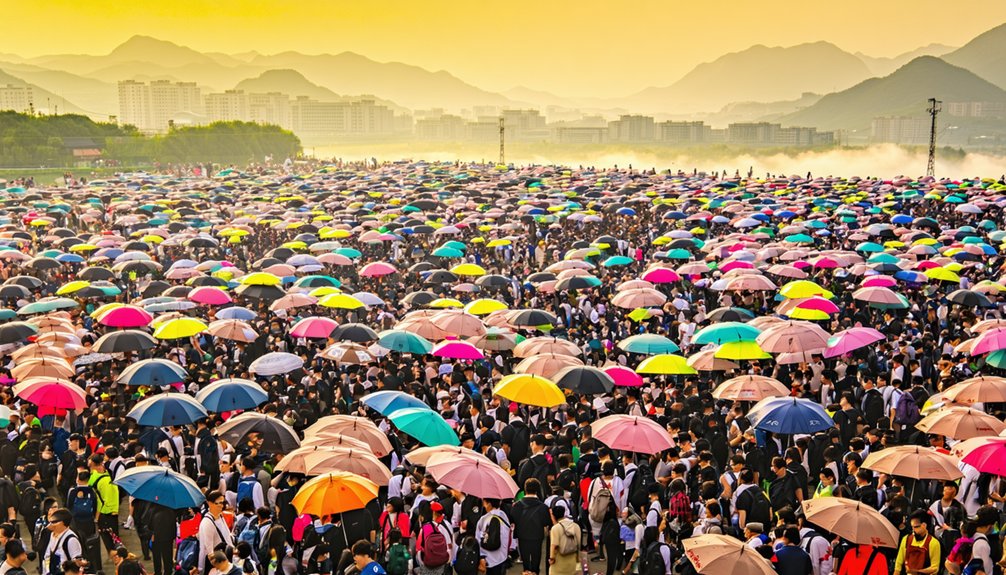
While planning a trip to China offers exciting possibilities, maneuvering the country’s peak holiday periods requires careful strategy. To avoid overwhelming crowds, you’ll want to steer clear of major holidays like National Day Golden Week, when domestic attractions saw 765 million visits in 2024, and the Labor Day period, which pushed cities like Nanjing beyond capacity with 10 million tourists. Popular destinations like Beijing and Shanghai consistently draw the largest tourist numbers throughout the year.
- Travel during off-peak seasons (November-March) for fewer crowds and better rates
- Book alternative destinations championed by the #ReverseTravel movement
- Arrive at attractions during early morning hours to beat the rush
Sustainable tourism models are emerging as younger travelers seek out lesser-known destinations, with over 70% of Gen Z prioritizing niche spots. Modern crowd management strategies include pre-booking requirements at popular sites like Xiaoxitian Monastery, which caps daily visitors at 10,000. Consider using high-speed rail instead of crowded airports during peak seasons.
Cost-Saving Travel Periods
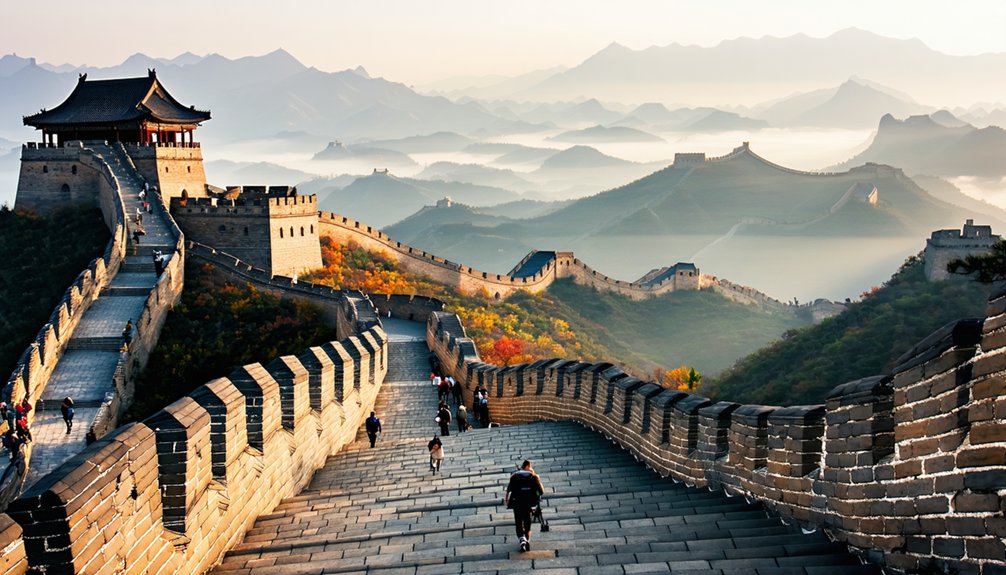
Managing costs is just as important as avoiding crowds when planning your China adventure. The most budget-friendly times to visit are during late winter (January-February) and late autumn (October-November), when accommodations pricing trends show discounts of up to 40% in northern cities like Beijing.
You’ll find the best value during shoulder seasons (March-May and September-October), with hotel rates dropping 30-50% compared to peak summer months. Local transportation discounts are more readily available during these periods, and you can score domestic flight deals on platforms like Ctrip and Travelzen. The rainy season from April to June offers significant savings for budget travelers.
For maximum savings, consider exploring southern China in winter, when the subtropical climate remains mild and tourist numbers are low. Just avoid major holidays like Chinese New Year and Golden Week, when domestic travel surges can inflate prices by up to 60%. Book flights 3-6 months ahead using price-tracking tools for the best rates.
Must-Visit Destinations by Season
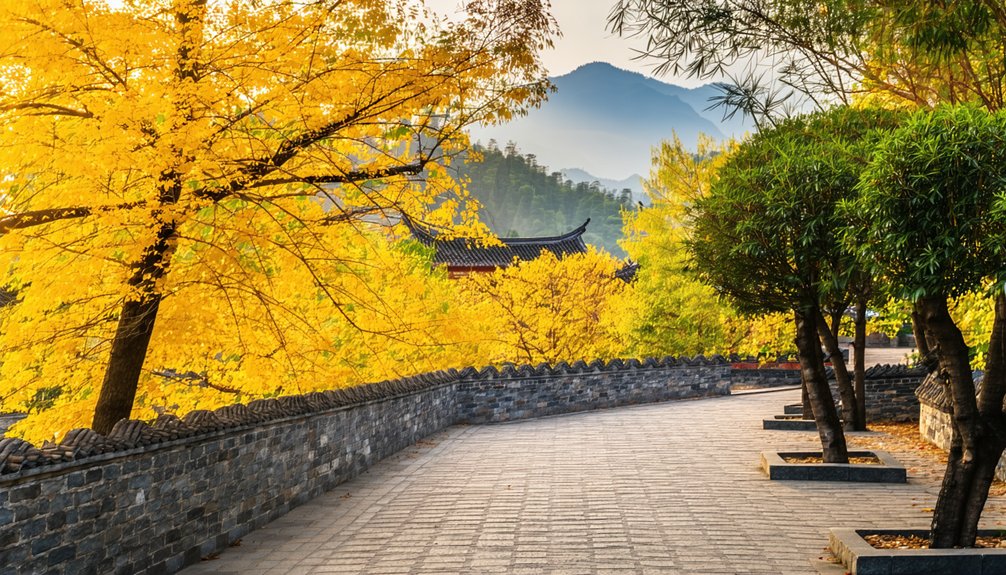
You’ll find spectacular cherry blossoms at Beijing’s Yuyuantan Park in spring, with additional viewing opportunities along the ancient city walls of Xi’an. For winter enthusiasts, Harbin’s world-famous Ice and Snow Festival showcases massive illuminated ice sculptures and hosts activities like Siberian tiger park visits. Autumn brings clear, pleasant days perfect for exploring iconic destinations like Guilin and Jiuzhaigou Valley. These seasonal highlights represent China’s most photogenic moments, from spring’s delicate pink petals to winter’s crystalline ice formations that transform cities into magical wonderlands.
Spring Cherry Blossom Routes
If you’re chasing cherry blossoms in China, you’ll find a stunning progression of blooms that sweeps across the country from January through April. Start your journey at Zhangping Yongfu Cherry Blossom Garden, where 42 varieties bloom amid scenic tea plantations, offering opportunities to combine blossom viewing with cultural tea ceremonies. Experience the garden’s magical atmosphere during special night illuminations that transform the landscape after dark.
- Coastal Route: Begin in Xiamen (March 5) and head to Shenzhen (March 7) for urban blooms against ocean backdrops
- Mountain Path: Explore Dali’s blossoms along Erhai Lake, then venture to Kunming for extended viewing through May
- Eastern Circuit: Hit peak season at Wuhan East Lake Park (March 18), followed by Shanghai Gucun Park (March 22), and conclude at Wuxi Turtle Head Isle’s International Cherry Blossom Festival with its impressive display of 30,000+ trees
Winter Ice Festival Attractions
China’s winter wonderland kicks into high gear during the Harbin Ice and Snow World festival, dazzling visitors with massive illuminated ice sculptures and crystalline palaces. You’ll find yourself submerged in a magical domain where towering snow sculpture displays transform the landscape into an otherworldly scene after dark. Visitors can enjoy sliding down slopes at the frozen Songhua River.
The festival offers more than just visual spectacles – you can plunge into cultural ice activities that let you experience winter traditions firsthand. From ice lantern making to traditional northern Chinese winter games, there’s an authentic connection to the region’s seasonal customs. While temperatures can drop well below freezing, the remarkable artistry and engineering of the ice structures create an unforgettable experience that makes braving the cold worthwhile. Don’t miss the chance to witness this unique celebration of winter’s raw beauty.
Weather-Based Activity Planning
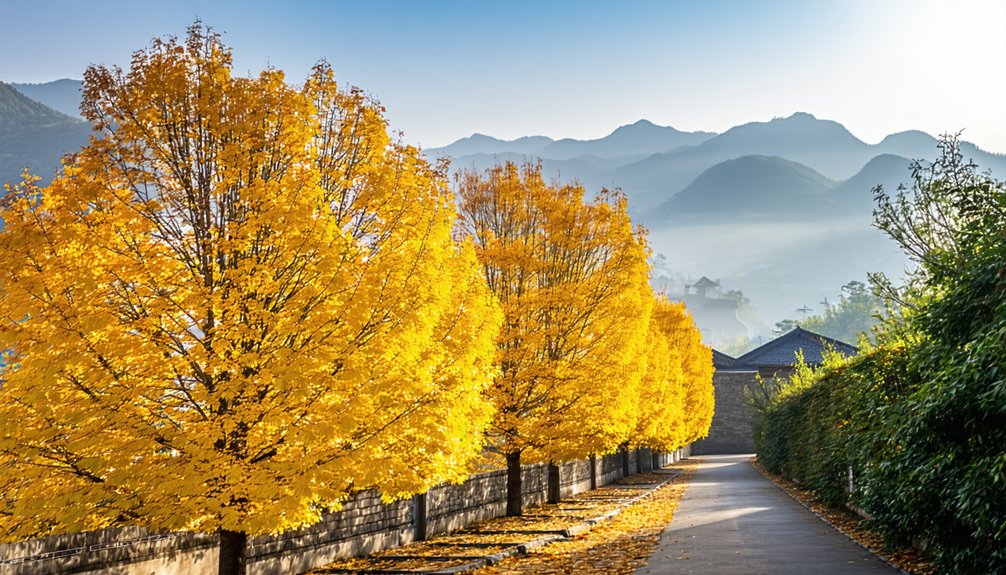
Planning activities around China’s diverse weather patterns will maximize your travel experience across this vast country. When mapping your itinerary, consider minimal rain patterns during autumn (September-November), which offers ideal conditions for outdoor exploration with temperatures between 15-26°C. For southern coastal visits, implement typhoon preparation strategies by scheduling trips outside the May-October storm season.
Autumn in China brings optimal travel conditions, with minimal rainfall and comfortable temperatures perfect for exploring this diverse nation’s outdoor wonders.
The pleasant temperatures during fall months offer a prime opportunity for exploring with fewer tourist crowds around.
- Trek the Great Wall near Beijing in autumn when clear skies and moderate temperatures create perfect hiking conditions
- Explore Tibet’s high-altitude destinations during summer to avoid extreme cold while escaping lowland heat
- Time Yangtze River cruises for spring when temperatures hover around 12-17°C with blooming landscapes
You’ll find favorable conditions for photography in Guilin during spring months, while winter presents unique opportunities for northern activities like Harbin’s Ice Festival. For maximum flexibility, target the shoulder seasons of late October-November when you’ll encounter reduced crowds and stable weather patterns nationwide.
Essential Seasonal Packing Guide
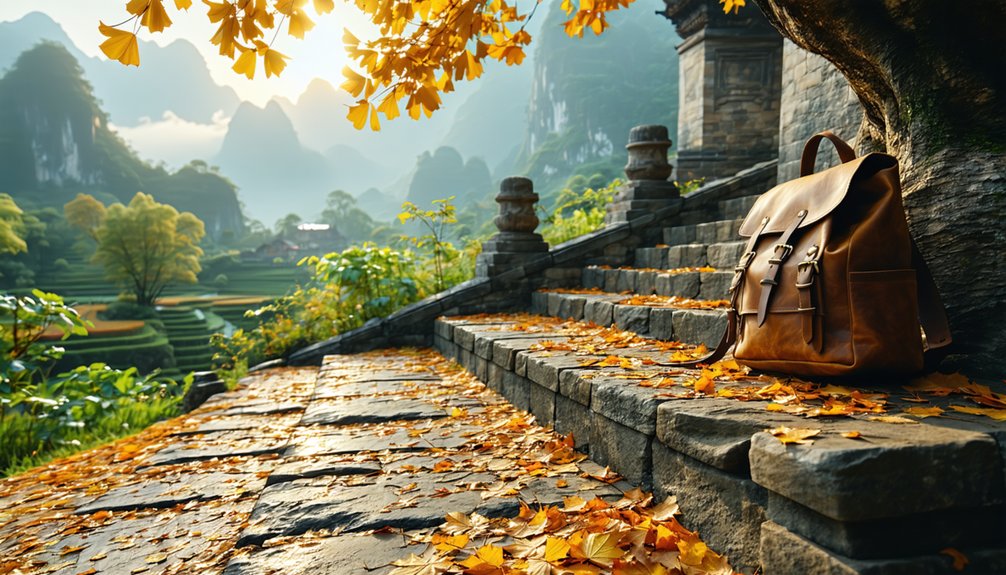
Packing appropriately for China’s distinct seasons will make or break your travel experience. During winter, you’ll need thermal base layers and wool socks in the north, where temperatures plummet below zero. Don’t forget your waterproof boots for western mountain regions and a windproof down jacket for nationwide use. For business travelers seeking versatile interchange outfits, focus on adaptable layering pieces. Lightweight jackets with removable liners work perfectly for spring and fall’s 45-72°F temperature swings. Merino wool sweaters and convertible hiking pants offer excellent flexibility as conditions change throughout the day. Summer demands quick-dry fabrics across all regions, with heavy-duty rain protection essential for southern monsoons. You’ll want adventure sandals in flood-prone areas and UV-protective gear in high-altitude zones. Remember to pack compression cubes to maximize luggage space, and don’t forget a universal power adapter with USB-C compatibility for your devices. The transitional seasons provide a more moderate climate, making them ideal times to explore China’s diverse landscapes.

